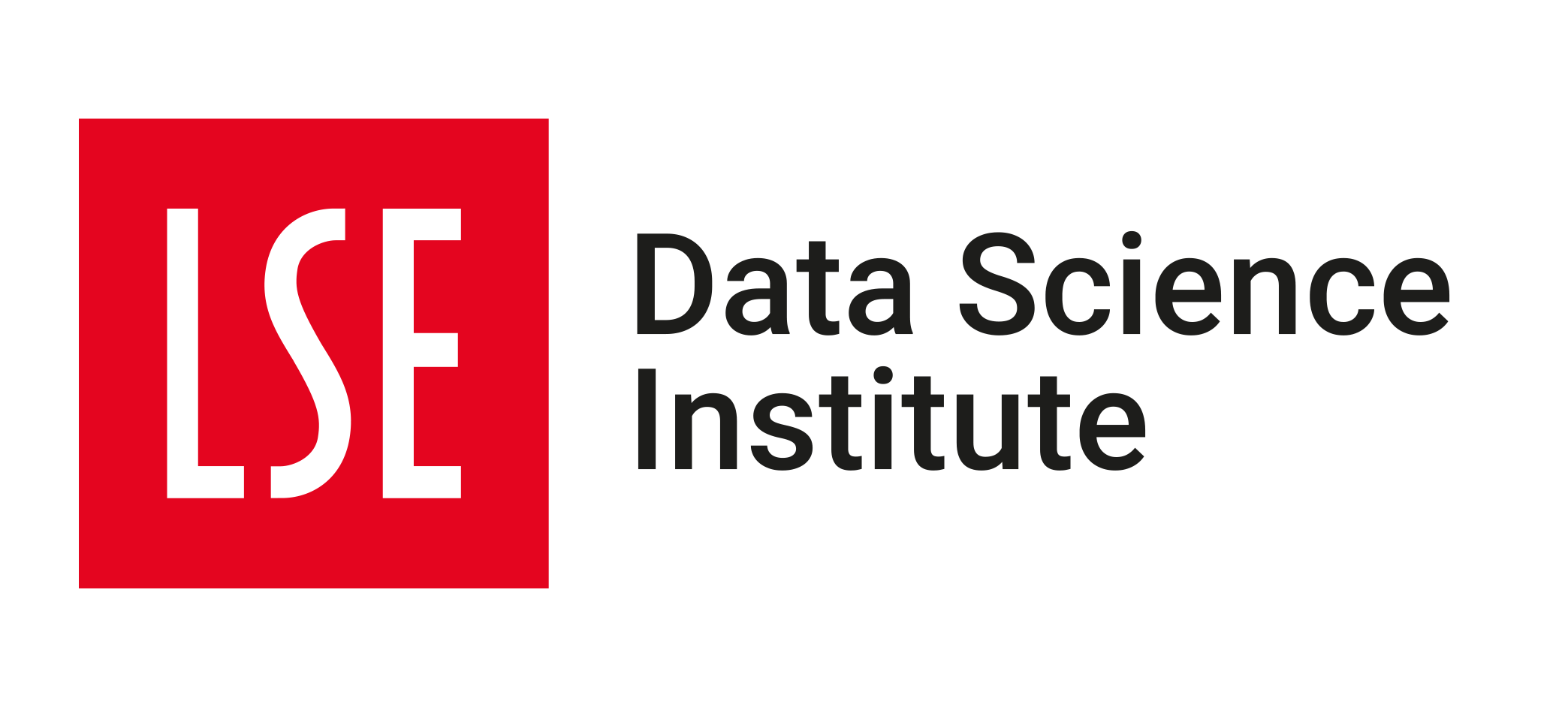🗓️ Week 01
Structure of this course
DS101 – Fundamentals of Data Science
16 Jan 2023
Who are we
The Data Science Institute

- This course is offered by the LSE Data Science Institute (DSI).
- DSI is the hub for LSE’s interdisciplinary collaboration in data science
Sign up for DSI events at lse.ac.uk/DSI/Events
The Data Science Institute

Activities of interest to you:
- CIVICA Seminar Series
- Careers in Data Science
- Social events
- Industry “field trips”
- Summer projects
Sign up for DSI events at lse.ac.uk/DSI/Events
Our courses
DSI offer accessible introductions to Data Science:
DS101
Fundamentals of
Data Science
🎯 Focus:
theoretical concepts of data science
📂 How:
reflections through reading and writing
DS105
Data for
Data Scientists
🎯 Focus:
collection and handling of real data
📂 How:
hands-on coding exercises and a group project
DS202
Data Science for
Social Scientists
🎯 Focus:
fundamental machine learning algorithms
📂 How:
practical use of ML techniques and metrics
Your lecturer

Assist. Prof. Lecturer
LSE Data Science Institute
- PhD in Computer Science (King’s College London)
- Background: Engineering, Bio & Health Informatics
- Former Lead Data Scientist
networks
optimisation
machine learning applications
data science workflow
Teaching Assistants

ESRC Postdoctoral Fellow
Department of Methodology
- PhD in Politics (Oxford)
- Background: Political Science
- Founder of WhoGov data set
- won the Lijphart/Przeworski/Verba data set award conferred annually by the American Political Science Association
social identity democratisation
political elites political economy
Who are you
| Course | Year | Department |
|---|---|---|
| BSc in Philosophy, Politics and Economics | 3 | Philosophy |
| BSc in Sociology | 2 | Sociology |
| BSc in Economics | 1 | Economics |
| BSc in Philosophy and Economics | 3 | Philosophy |
| BSc in Philosophy, Logic and Scientific Method | 3 | Philosophy |
| BSc in Sociology | 2 | Sociology |
| BSc in Economics | 1 | Economics |
| General Course | 1 | General Course |
| BA in Geography | 3 | Geography |
| General Course | 1 | General Course |
| BSc in Economics and Economic History | 3 | Economics |
| BA in History | 1 | History |
| BSc in Politics and Economics | 3 | Government |
| BA in History | 3 | History |
| Department | n |
|---|---|
| Economics | 3 |
| Philosophy | 3 |
| General Course | 2 |
| History | 2 |
| Sociology | 2 |
| Geography | 1 |
| Government | 1 |
Source: LSE For You. Last Updated: 16 January 2023
How did we get here?
This abundance of data is strongly associated with the dramatic changes in technology in the past few decades.


St.Peter’s Basilica at the Vatican in
📅 19 April 2005
when Ratzinger
was elected the 265th pope.
St.Peter’s Basilica at the Vatican in
📅 13 March 2013
when Pope Francis
was elected the 266th pope.
Source: (Kolawole 2013)
We changed how we consume music 🎧

To interact with this plot, check reference (Fischer-Baum 2017) at the end of this presentation.
We changed how we consume video 🎞️

To interact with this plot, check reference (Fischer-Baum 2017) at the end of this presentation.
Smartphones 📱 are a very recent thing

To interact with this plot, check reference (Fischer-Baum 2017) at the end of this presentation.
We spend a lot more time connected
… and our social media habits keep on changing
The possibilities
- Humans and machines nowadays generate A LOT of data ALL THE TIME
- It has become cheap to collect and store this data
- This abundance of data opens up new possibilities for research & policy-making
New data to answer old questions:
How do rumours spread?
New questions enabled by new data:
Is social media a threat to democracy?
What do we mean by data science?
Data science is…
“[…] a field of study and practice that involves the collection, storage, and processing of data in order to derive important 💡 insights into a problem or a phenomenon.
Such data may be generated by humans (surveys, logs, etc.) or machines (weather data, road vision, etc.),
and could be in different formats (text, audio, video, augmented or virtual reality, etc.).”
The mythical unicorn 🦄
knows everything about statistics
able to communicate insights perfectly
fully understands businesses like no one
is a fluent computer programmer
In reality…
We are all jugglers 🤹
- Everyone brings a different skill set.
- We need multi-disciplinary teams.
- Good data scientists know a bit of everything.
- Not fluent in all things
- Understands their strenghts and weaknessess
- They know when and where to interface with others

The
Data
Science
Workflow
The Data Science Workflow
The Data Science Workflow
It is often said that 80% of the time and effort spent on a data science project goes to the abovementioned tasks.
The Data Science Workflow
- This is the bit that typically gets everyone excited about data science.
- Machine Learning is a sub-field of Artificial Intelligence that focuses on developing algorithms that can learn from data.
What do you think of this image?

“Théâtre D’opéra Spatial,” by Jason Allen. Colorado State Fair.
An algorithm created this image!
- Instead of a 🖌️ brush (physical or digital), the author typed a few words into an algorithm
- It took him ⌛ 80 hours to find the “right words” to express his idea

- Jason Allen used a generative Artificial Intelligence (AI) algorithm called ‘Midjourney’
- ⏭️ Let’s look at a few other examples
What about ChatGPT?


(Unsolved) questions about the generative AI revolution
Who owns the rights to the images?
“a horde of octopuses protesting during the French revolution, photojournalism”

What biases do these tools propagate?

“a futuristic octopus-like alien holding a jar that contains the source of true happiness”
Are these tools safe?
“a futuristic octopus-like alien holding a jar that contains the source of true happiness”

Time for coffee ☕

After the break:
- DS101L website
- Syllabus
- Assessments
- Tools
- This week’s coursework
References

LSE DS101L (2022/23) – Week 01 | archive